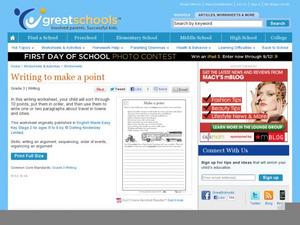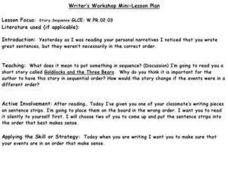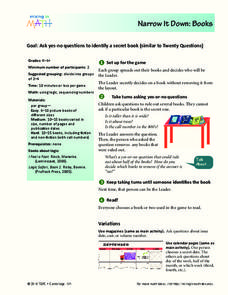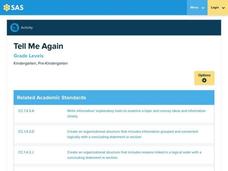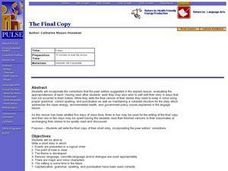Curated OER
Logical Sequence-- Lessons 1,2,3
In this language arts worksheet, students discover the importance of logical sequence in stories. Students read 5 short stories or letters and put them in the correct order. This is a cut and paste page.
For the Teachers
Story Strips Sequencing
What happens next? Work on story sequence with a lesson that prompts kids to put a story back in order. Additionally, they discuss what would happen if one event was missing from the sequence.
For the Teachers
Sequence Plot Chart
Your kids can identify the plot sequence of a short story, but what about an informational article? Have them examine the chronological order of events in informational texts with a activity on the sequence of events.
Curated OER
Logical Sequence
Students examine logical and illogical sequences in writing. They identify illogical sequences of sentences in a letter. Students retell short stories using a logical sequence and students place sentences in logical order.
Curated OER
Writing to Make a Point
Begin your persuasive writing with a helpful exercise on making points. With a list of ten points on transportation in a city, third graders map a logical order to their argument. They then write one or two paragraphs about the points...
Curated OER
Joining Sentences
Sentence combining meets multiple objectives for writers, and they are all available in this informational text exercise. Learners read a mixed-up excerpt about the history of chess, putting 15 sentences into logical order. Have a...
Polk Bros Foundation
I Can Sequence Important Events
After reading any short informational or fictional text, ask your class to analyze the important events. They note down three important events on a short timeline, describing the events with either words or drawings. After this, pupils...
Scouts
The Deadly Picnic: A Lab on Deductive Reasoning
Whodunnit? Find out who killed Mr. Brooks through a logical examination of evidence. Class members fill out a couple of data tables to help them pin down the suspect. After they've figured out just who the culprit is, pupils compose...
Curated OER
Sunrise Sequencing
Students examine sequencing events by discussing what they do each morning. They complete a four-panel sequence of events assignment, drawing a picture and writing a sentence for each box in the panel.
Curated OER
Presenting Information
How do you make a pizza? Scholars examine a recipe for one of their favorite dishes. After reading the eight steps, they must re-write the steps in order. Although this offers great printing practice, younger writers may find the narrow...
Curated OER
Problem Solving: Draw a Diagram
This problem solving PowerPoint presents a detailed, logical sequence of steps to follow in order to solve a story problem. The thinking processes described are given in text and represented by a visual model. After discussing the...
Curated OER
Writers Workshop Story Sequence
Students read stories and explore the importance of sequential order. In groups, students are given sentence strips. Students holding the sentence strips, place themselves in a logical order to make a story. Individually, students...
Curated OER
The Beginning, The Middle, & The End
Cut magazine pictures into three sections, having your youngsters piece the pictures back together. With this fun activity, they discover the importance of sequencing a story. Then they use a fun template (shaped like a burger) to write...
Curated OER
Things Happen in Order
In this order of events worksheet, students read an example of order of events, then write pairs of words in their logical order. One example is completed for students
Curated OER
More Congruent Triangles
For this congruent triangles worksheet, 10th graders solve 6 various forms of problems that include a proof and a word problem. First, they draw and label triangles and indicate the additional pairs of corresponding parts that would have...
Curated OER
Narrow It Down: Books
Students ask yes-no questions to identify a secret book. In this asking questions lesson plan, students ask yes or no questions about books to identify a secret book. Students identify the book and then read one of the example books.
Pennsylvania Department of Education
Tell Me Again
Students demonstrate how to retell a story in sequential order. In this reading comprehension lesson, students listen to a suggested read aloud, such as Little Boy Blue. Additionally, students practice retelling the story by using...
Curated OER
The Final Copy
Write short stories in which events are presented in logical order, point of view is clear, theme and characters are developed. Middle schoolers also work on sensory language, concrete language and/or dialogue. They establish their...
Curated OER
Understanding and Using Root Words to Expand Vocabulary
Middle schoolers engage in a lesson which reminds them that root words indicate the base meaning of a word, and that those roots are found in many different words that have similar meanings. Pairs of pupils use construction paper and...
Curated OER
The Day Jimmy's Boa Ate the Wash
Students read the story The Day Jimmy's Boa At the Wash and put the event boxes in order from the beginning to end of the story. In this sequencing lesson plan, students do this on the computer.
Pennsylvania Department of Education
6 Traits: Organization
Students make logical patterns in their writing to demonstrate the trait of organization. In this organization lesson plan, students focus on events proceeding logically.
Curated OER
Narrative Nuts and Bolts
After viewing slides and reading about child labor, young authors compose an original narrative story. They practice note-taking skills and work to effectively engage a reader by incorporating plot, logical order, complex characters,...
Curated OER
Alphabet Sideshow
Students practice sound and recognition of letters in alphabetical sequence. They gain an understanding of letter sounds and order. They create a slide show with graphics and text. They present their slide show to the class.
Shmoop
ELA.CCSS.ELA-Literacy.RI.11-12.3
Make analyzing the sequence of events in an informational text easy. Ask readers to craft a one-sentence summary of each paragraph in a document and create a text map. To demonstrate their understanding of the process, participants read...




